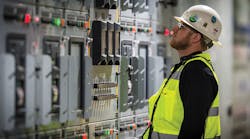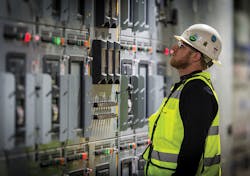The NEC has Articles providing installation requirements for various types of electric power production sources. Each source is also covered by Art. 705 if it’s “interconnected.” But what does “interconnected” mean? The definition doesn’t appear in Art. 705 or in Art. 100, but the defining characteristic of an interconnected power production source is that it operates in parallel with the primary source of power. We glean this not from a definition in 705.2 (there isn’t one), but from the scope [705.1] and the system installation requirement [705.6].
Note the use of the word parallel. A generator used for peak load shedding isn’t connected in parallel with the primary source. It’s connected in parallel with some rung on the distribution system, such as a feeder supplying specific loads. Because this generator isn’t connected in parallel with the primary source, it’s not covered by Art. 705. A careful reading of the point of connection requirement [705.12] helps underscore what’s meant by parallel. Think back to your Electricity 101 days when you drew out a circuit to solve a problem for two resistors in parallel; it’s that kind of meaning.
Note also the use of “primary source.” Why doesn’t Art. 705 simply say the “utility?” That’s because utility power isn’t necessarily the primary source. In some cases, it’s not a source at all.
No sole
Suppose you’re working on a project for the Forestry Service. It’s a remote observation tower with a solar panel as its sole supply. By definition, this power source (being sole) is not interconnected.
If you added a wind generator in parallel with the solar power source and your one-line showed the solar power system as the primary source, the wind generator would be an interconnected power production source. Any time a power production source is the sole source, it’s not interconnected. But a second power production source might be, as in the case just described. The key is it must be connected in parallel with the primary source.
Why interconnect?
A common reason to interconnect is to keep the facility from losing power. For example, you’ve got a large diesel power production system (multiple generators, day tanks, the whole shebang) sized to power the facility. It’s interconnected so it can simply “step in” when primary power is lost (maybe with batteries to support the load during the transition from dead stop to full power, and those would be interconnected too).
Interconnecting electrical power sources gives you the option to use the source that best fits changing conditions. For example, a major data center (near Washington, D.C.) switches from its primary source (the utility) to an interconnected on-site power production source whenever thunderstorms are within 12 miles of the facility. This greatly reduces the threat of lightning-induced transients.
Some facilities have layers of interconnected electric power sources to avoid any chance of going dark. Maybe there’s a utility power outage, so you lose your primary source. You have a set of natural gas generators interconnected with the utility service, so those now power your facility. Suppose the outage was caused by an earthquake, and your natural gas line is out as well. You also have an interconnected set of LP gas generators, so your facility runs on those. When the LP gas runs out, you switch to the set of diesel generators that is also interconnected.
Or you might run wind or solar as the weather permits, to reduce your total draw from the grid. When it’s windy (or sunny), you’re spending less on electricity. But when the wind dies (or it’s dark outside), you don’t have to shut equipment down; you’re running it off the grid.
Remember, being in parallel is the key. Two power sources can share the job of supporting the load, but they are “interconnected” only if in parallel. For example, you select a portion of the loads for one source and a portion of the loads for the other. These aren’t in parallel. If either source can carry the total load, you can interconnect them to alternate between one source or the other.
Connection requirements
Article 705 provides connection requirements under four conditions. These are not mutually exclusive; in fact, it’s possible for a single installation to have all four conditions present. These are:
1. Connection is on the supply side of the service [705.12(A)]. The ratings of all overcurrent devices connected to power production sources can’t exceed the rating of the service.
2. You have an integrated electrical system [705.12(B)]. The requirement is the power source must incorporate protective equipment per Art. 685 (which, not by coincidence, is titled, “Integrated Electrical Systems”).
3. The aggregate of the non-utility sources exceeds 100kW (or the service exceeds 1kV) [705.12(C)]. You must have professional maintenance and all that entails. This includes qualified maintenance personnel, safeguards, documented procedures, and protective equipment.
4. You have utility-interactive inverters [705.12(D)]. The requirements are extensive compared to the other requirements of 705.12. It’s worth noting that the bus or conductor ampere rating requirements [705.12(D)(2)] are all new with the 2014 NEC and take up about half of the requirements included in 705.12 “Point of Connection”.
The 2014 NEC added an AFCI requirement here, too (for specific installations on smaller systems) [705.12(D)(6)]. And all of Part II covers requirements for these inverters [705.60 through 705.100].
Keep them posted
Wherever you connect your system, you must post a permanent plaque or directory that denotes all power sources on the premises [705.10]. This plaque or directory is often there just because it has to be, and thus is of “afterthought quality.” That is a mistake.
Yes, you could tack up handwritten scrawl in permanent ink and check off the box that you satisfied the requirement. But, if you’re the:
• Installing contractor, is that the image you want to leave with your customer?
• Plant electrical engineer, is this the image you want to send to your management?
If you answered no, consider doing this. Mark up a plan view of the building with the power sources identified in their respective locations. Add some external landmarks such as streets around the property and internal landmarks such as front lobby and loading dock. Have a sign shop use this as the basis for plaques made of appropriate materials.
These are interchangeable; customize one for each location with a “You Are Here” arrow. And if you really want to help first responders, provide an emergency light to illuminate each one.
Disconnect and overcurrent protection
You must provide a means of disconnecting all ungrounded conductors of an electric power source from all other conductors. But you don’t need the disconnect for equipment that’s an integral part of a power source exceeding 1kV [705.21].
The 2014 NEC changes overcurrent protection location requirements, with an entirely new subsection [705.31]. Now, supply side overcurrent protection must be within 10 ft of where the power source conductors connect to the service [705.31]. But you can exceed this limitation if you install cable limiters or current-limited circuit breakers at the service connection point.
Part III [705.130 and 705.143] is really short, and it’s basically about providing the necessary overcurrent protection per Art. 240 and protecting the generators per 445.12. It also tells you to provide your synchronous generator, if you have one, with the equipment necessary to maintain the synchronous condition.
When primary power fails
Upon loss of the primary source, your system must automatically disconnect from the primary source and not reconnect until that source is restored [705.40]. A similar restriction applies in the event of phase loss [705.42]. There are exceptions (e.g., listed equipment can remain connected but must automatically cease exporting power).
Why this requirement? You don’t want your power production equipment trying to supply the whole grid during a power outage. That would probably destroy your power generation equipment. And the utility doesn’t want you frying its employees; they get rather touchy about that.
Get interconnected
Article 705 has the potential to supplement many other Articles. This can easily lead to omitting important requirements. You can prevent that by thinking in terms of Code order. It flows like this:
• The premises wiring and equipment must conform to Chapters 1 through 4.
• Each power production source must conform to its relevant Article (e.g., solar is 690).
• Apply Article 700, 701, or 702 if you are using a system covered by one of those.
• Finally, apply Art. 705. Remember that this Article focuses on the interconnection of sources, not on the sources that are interconnected.
Lamendola is an electrical consultant located in Merriam, Kan. He can be reached at [email protected].






